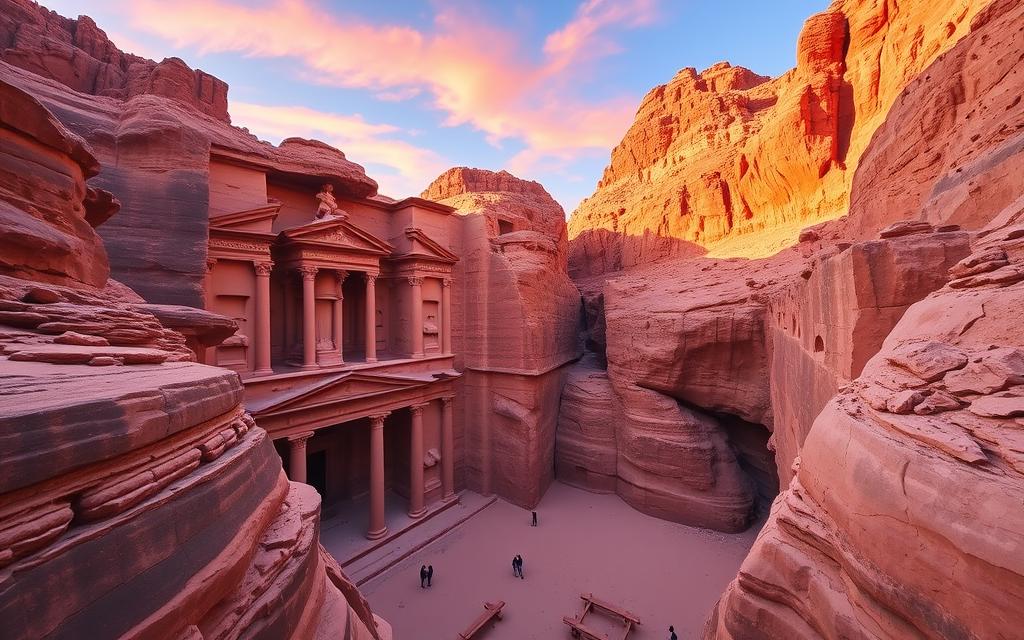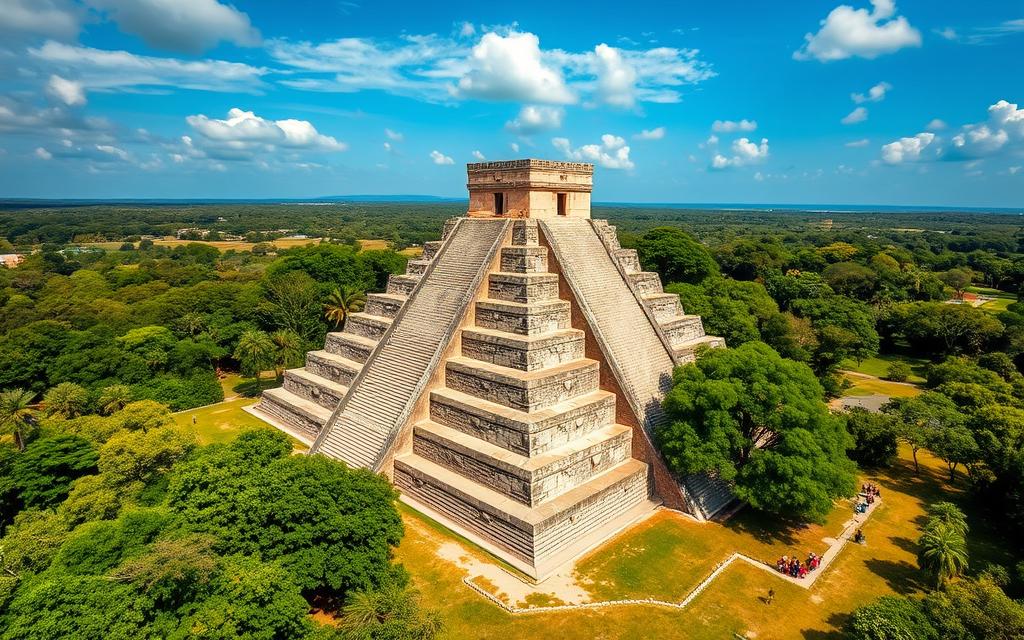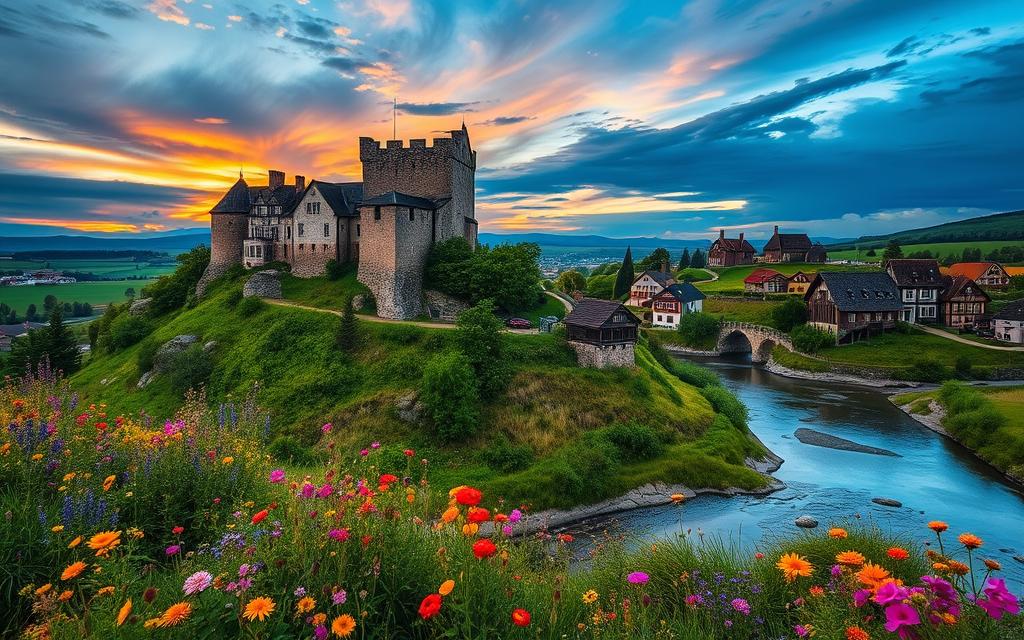Imagine stepping back in time, surrounded by the grandeur of ancient civilizations. You’re captivated by the timeless beauty of cultural landmarks. This is what heritage tourism is all about. It’s a journey that takes us beyond today, letting us discover our shared global heritage.
The world is full of amazing heritage sites. Places like Angkor Wat in Cambodia and Petra in Jordan amaze people everywhere. These sites are full of wonder and inspiration.
As we explore, we’ll learn about the stories, traditions, and architecture of these places. These sites are like windows to the past. They help us connect with history and appreciate different cultures. Let’s uncover the secrets of these incredible places and make memories that last a lifetime.
Angkor Wat: Architectural Marvel of Ancient Khmer Civilization
In the heart of Siem Reap, Cambodia, Angkor Wat is a stunning example of ancient Khmer grandeur. Built in the 12th century, it was first a Hindu temple and later became a Buddhist site. It’s famous for its massive size, detailed carvings, and architectural genius.
History and Significance
King Suryavarman II of the Khmer Empire built Angkor Wat. It’s the world’s largest religious monument, covering over 400 acres. The five towers symbolize Mount Meru from Hindu mythology, making it a key cultural and religious site.
Over time, the temple changed from Hindu to Buddhist, showing the Khmer people’s spiritual growth.
Experiencing Angkor Wat
Visitors can dive into the temple’s beauty and history. The Angkor Archaeological Park, which includes Angkor Wat, is best explored by tuk-tuk. One-day passes let you explore the vast site, see the detailed carvings, and enjoy the sunrise or sunset.
Located just north of Siem Reap, Angkor Wat is a chance to see the Khmer civilization’s grandeur up close.
| Key Facts about Angkor Wat | Statistics |
|---|---|
| Size of Angkor Wat | More than 400 acres |
| Siem Reap Population | Exceeding 200,000 people |
| Angkor Wat Visitors per Year | Around 500,000 |
| Angkor Archaeological Park Size | Around 400 km2 |
“The ruins of Angkor are like no other place on earth. They are a testament to the grandeur of the Khmer civilization and a reminder of the enduring power of human ingenuity and creativity.” – Travel Blogger, Jane Doe
Petra: The Rose-Red City Carved into Rock
In Jordan’s southwestern desert, Petra is a marvel of the Nabatean civilization. It’s a city carved into pink sandstone cliffs. Visitors see towering temples and tombs as they enter through a narrow canyon.
Petra was once a key spot for trade. The Nabateans exchanged goods like incense, silks, and spices along ancient routes.
A Journey Through Time
Exploring Petra is like stepping back in time. You’ll see the remnants of a fascinating civilization. The city’s architecture is carved into the rock, a true wonder.
Petra has been around since ancient times. It connected Arabia, Egypt, and Syria-Phoenicia. Its unique design blends with the mountains, creating a breathtaking sight.
Exploring Petra’s Wonders
Wadi Musa is the gateway to Petra. It has hotels for all budgets. A one-day ticket lets you see the “Treasury” and other ruins.
Walking through Petra’s canyons is unforgettable. You’ll see detailed carvings and learn about the Nabateans. It’s a journey into the past.

Petra’s architecture spans centuries, blending Eastern and Hellenistic styles. It’s a testament to ancient ingenuity. But, it faces erosion and tourism pressure since becoming a UNESCO site in 1985.
Heritage Tourism Sites: Portals to Ancient Realms
Preserving Cultural Heritage
Heritage tourism sites around the world are key to understanding our past. They let visitors connect with ancient cultures and marvels. But, it’s important to protect these sites for the future.
Travelers should be careful and leave nothing behind but footprints. This way, they help keep these places safe for others to see. It’s our duty to preserve these sites for future generations.
By choosing sustainable tourism, we help protect our cultural heritage. Tourism brings in $7.2 trillion a year and supports 200 million jobs. It’s a big way to help local economies and communities.
“Heritage tourism sites around the world serve as vital portals to the past, offering visitors a unique opportunity to connect with ancient civilizations, architectural marvels, and cherished cultural traditions.”
But, we must be careful. Too much tourism can harm these sites. It can lead to overcrowding, higher prices, and damage to the environment. Responsible tourism helps avoid these problems.
Places like Angkor Wat in Cambodia and Petra in Jordan are treasures. They let us see the history and traditions that shaped our world. By keeping these sites safe, we protect our shared heritage for the future.
Chichén Itzá: Mayan Masterpiece of the Yucatán
Chichén Itzá is a treasure on Mexico’s Yucatán Peninsula. It shows the Mayan civilization’s architectural and cultural wonders. This ancient city was huge, thriving from the 4th to the 15th centuries CE.
Visitors marvel at the site’s many architectural styles. The El Castillo, a step pyramid, is a highlight. It shows the Mayans’ skill in engineering and astronomy.
Architectural Grandeur
The El Castillo, also called the Temple of Kukulkan, is stunning. It’s 79 feet tall with detailed carvings. It’s special because it shows the sun’s position during the spring and fall equinoxes.
The Great Ball Court and the Temple of the Warriors are also impressive. The Great Ball Court is the biggest in Mesoamerica. The Temple of the Warriors was a center for religious and cultural life.
Exploring the Ancient City
Chichén Itzá is close to Cancún and Valladolid. You can buy tickets to see the ruins. There, you can also find cenotes, or deep limestone sinkholes.
Valladolid has many places to stay. This lets visitors enjoy the Yucatán’s culture more.

“Chichén Itzá was a thriving Mayan city for over 600 years, leaving behind a legacy of architectural marvels that continue to captivate visitors from around the world.”
Machu Picchu: Incan Citadel in the Andes
The site of Machu Picchu sits high in the Peruvian Andes, almost 8,000 feet up. It’s a stunning example of the Inca civilization‘s skill and creativity. Built around 1450, it flows down a mountain, surrounded by the Sacred Valley‘s sharp peaks.
To get to Machu Picchu, you can take a train from Cusco or hike the famous Inca Trail. This hike takes you through beautiful landscapes. Even though it was abandoned during the Spanish conquest, Machu Picchu still draws visitors from everywhere.
The Machu Picchu Historic Sanctuary is at 2,430 meters in a tropical forest. It spans 32,592 hectares of mountains and valleys. The “La Ciudadela” monument is over 2,400 meters high.
“Machu Picchu is the most magnificent urban creation of the Inca Empire at the height of its power and achievement.”
There are about 200 structures in Machu Picchu. They were used for religious, ceremonial, astronomical, and farming purposes. The area also has roads, trails, canals, and terraces, showing the Inca’s advanced planning.
Despite its remote and high location, Machu Picchu still amazes visitors with its beauty and preserved ruins. As a UNESCO World Heritage Site and a Peruvian Historic Sanctuary, it’s protected for the future.
Heritage Tourism Sites: Portals to the Past
Heritage tourism sites around the world are like windows to the past. They let travelers dive into the richness of history. Places like Angkor Wat in Cambodia and Stonehenge in England show off amazing architecture and cultural treasures.
Heritage tourism offers many experiences. You can visit museums, historic villages, and even meet living cultural communities. These sites keep our history alive and let us see the traditions and stories of a place.
Visiting these sites is more than just curiosity. It helps protect our cultural heritage for the future. By being respectful and careful, travelers support tourism that preserves these treasures for years to come.
Source Links
- https://www.planetware.com/world/top-world-heritage-sites-per-1-2.htm
- https://whc.unesco.org/en/list/
- https://www.thetimes.com/travel/inspiration/top-10-unesco-world-heritage-sites-lg80tsj8f
- https://www.history.com/topics/landmarks/angkor-wat
- https://whc.unesco.org/en/list/668/
- https://whc.unesco.org/en/list/326/
- https://en.wikipedia.org/wiki/Petra
- https://medium.com/globetrotters/petra-the-rose-red-city-and-7th-wonder-of-the-world-70e18c28973e
- https://www.chrie.org/assets/docs/JHTC-case-notes/JHTC-vol-7/JHTC_Vol7Issue1_Cobb_case.pdf
- https://tompkinscountyny.gov/files2/tourism/Heritage Tourism Implementation Plan_2-4_for STPB approval.pdf
- https://gtg.webhost.uoradea.ro/PDF/GTG-3-2024/gtg.55317-1289.pdf
- https://www.haciendachichen.com/chichenitza
- https://www.themayanruinswebsite.com/chichen-itza.html
- https://en.wikipedia.org/wiki/Machu_Picchu
- https://whc.unesco.org/en/list/274/
- https://www.metropolitan-touring.com/machu-picchu/
- https://antidisplacement.org/tool/heritage-tourism-programs/
- https://www.familysearch.org/en/blog/heritage-tourism
- https://www.gsa.gov/real-estate/historic-preservation/explore-historic-buildings/heritage-tourism

